In this feature-length project update, Researcher Network member, Chris Bryant, discusses his research that led to the creation of a guide for effective animal campaigning for those with limited resources.
I am very happy to publish this review with The Vegan Society. Animal advocacy organisations with limited budgets may not have time to dedicate to this type of advocacy research, whilst academic researchers with an interest in animal advocacy research might find such work inappropriate for publication in academic journals. Nevertheless, research on effective animal advocacy is vital to ensuring that we can help as many animals as possible, and it is excellent that The Vegan Society is providing a platform to share this kind of work.
Chris Bryant, The Vegan Society Researcher Network.
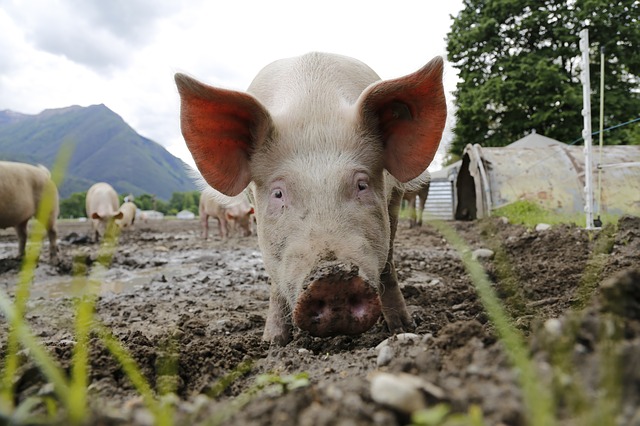
Summary of Findings
I reviewed foundational and empirical research from a number of sources associated with effective animal advocacy. I identified a number of strategies for alleviating the most animal suffering possible through consumer-facing advocacy. Campaigns should focus on farmed animals, and especially chickens and fish, which suffer more and in far greater numbers than other animals. Animal cruelty messages appear to be more effective than health- or environment-based messages on aggregate, though other messages may also be effective for some consumers. Advocates should be wary of messages which might nudge consumers away from red meat and towards white meat, since this would lead to more animal suffering. Whilst some demographics (women, young people, left-leaning people, city-dwellers) are more receptive to vegan advocacy, the optimal strategy is likely to be reaching as many people as possible. There is mixed evidence on the effectiveness of leafleting and online adverts, and some evidence suggests that documentaries are likely to be the most compelling medium.
Introduction
This is a guide to effective vegan campaigning. The aim is to present the research on effective vegan advocacy in order to help the reader create the greatest possible change in consumer behaviour. This means that, for each dollar or hour the reader spends on consumer-facing campaigns, more animal suffering will be spared. The development of this guide is based on the principles of effective altruism.
It is worth noting that consumer-facing campaigns are likely not to be the best use of an animal advocacy organisation’s resources in terms of reducing animal suffering. It is likely that a focus on institutions rather than individuals (such as legal and corporate policy reform) is more effective (Sentience Institute, 2018). However, many animal advocacy organisations will also run campaigns to persuade consumers to reduce their animal product consumption regardless. Indeed, this may be an important part of their strategy, and in the long term could create not only more vegans, but more animal advocates. Therefore, this guide will focus on how to create the most persuasive consumer-facing campaigns.
This guide is based on academic and advocacy research primarily sourced from Animal Charity Evaluators’ research library, Faunalytics’ animal tracker, Humane League Labs, and Mercy For Animals. It will cover advocacy strategy, message content, which consumers to target, and what media to use.
2. Strategy
It is important to make active decisions about what areas to focus on, because this determines where we allocate resources. Of course, we want to help all animals, but given limited resources, we need to prioritise. Every dollar/hour that we spend on helping cows is a dollar/hour that we cannot spend on helping chickens. By carefully choosing which problems to focus on, we can maximize the suffering we alleviate with a given amount of resources.
2.1 Focus on Farmed Animals
In addressing animal suffering as an issue, we face a choice about which areas to focus on. We might be concerned about animals in labs, in shelters, or on farms. As shown here in the graph on the right, about 65% of donations to animal charities in the USA go to animal shelters.
Source: Animal Charity Evaluators (2016)
However, as shown in the graph on the left, the vast majority of animals (99%) are on farms, whilst only a tiny fraction are in shelters or labs. This is a relatively neglected area, since just a small fraction of donations to animal charities go to farmed animal advocacy. Moreover, it is a tractable problem: progress can be made to reduce the number of animals on farms and the extent to which they suffer.
Therefore, farmed animal advocacy is by far the best use of resources to reduce animal suffering. Animal Charity Evaluators (2016) recommends farmed animal advocacy as the area most worthy of our attention and resources.
2.2 Focus on Chickens and Fish
According to Animal Clock (2018), in the UK each year, we kill:
It is difficult to comprehend the true scale of any of these numbers, but displaying them graphically can help us appreciate the proportions between them. Here, we can see that the vast majority of land animals we kill are chickens:
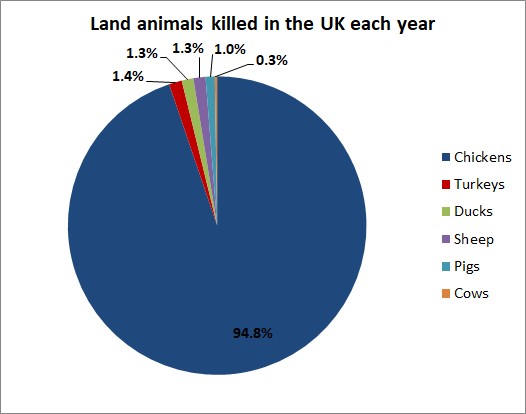
Chickens account for almost 95% of all land animals killed in the UK. When we include fish, we can see that fish and shellfish are killed in vastly higher quantities again, as shown here:
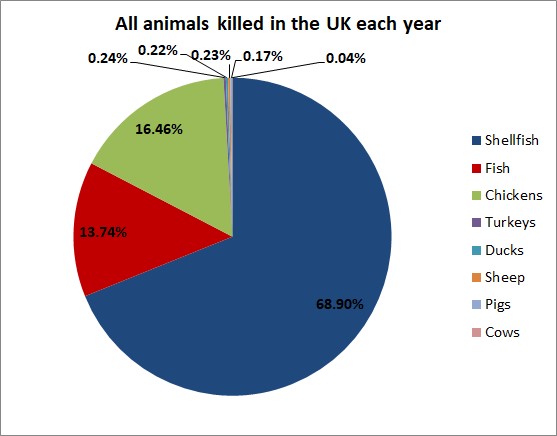
Here we can see that fish and shellfish account for 83% of all the animals killed. Together, chickens, fish, and shellfish account for more than 99% of the animals killed. This is largely because they are relatively small: whilst one cow yields around 200 kilograms of meat, one chicken yields just two kilograms. Therefore, one must rear 100 times as many chickens to get the same amount of meat as one cow.
It is true that cows live for much longer, and therefore endure more suffering than chickens. Beef cows typically live for 395 days, whereas broiler chickens live for just 42 according to Tomasik (2018a). However, even accounting for these differences, chickens account for more than 90% of the days of suffering of land animals.
Moreover, there is reasonable evidence that chickens (and pigs) suffer a great deal more than cows in typical farming conditions (Norwood & Lusk, 2011; Tomasik, 2018a), though this is not straightforward to quantify. Norwood and Lusk (2011) rated the welfare of different farmed animals on a scale of -10 to +10, where negative numbers indicate a life not worth living. They rate beef cattle at +6, and dairy cows at +4. Broiler chickens are rated at -1, and pigs and caged hens are rated at -5. These numbers are based on USA practices, but chickens and pigs still suffer more than cows in the UK (MacAskill, 2015).
There is also an argument to be made that some animals may be ‘more sentient’ than others. Tomasik (2018b) considers the argument that a larger brain entails greater capacity for suffering. One might take the view, therefore, that smaller animals such as chickens suffer less than larger animals such as cows. This is difficult (perhaps impossible) to verify, though interestingly Tomasik (2018a) controls for this, and still finds that fish and fowl suffer much more per kilogram of food produced than other animals. Accounting for the number of days an animal lives, how bad their living conditions are on average, how much meat (or other product) they produce, how bad their death is, and how sentient they are, Tomasik estimates the following equivalent days of suffering per kilogram of animal product demanded.
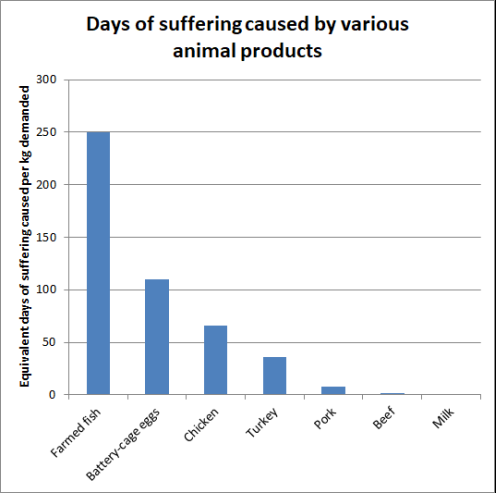
Although there is some inevitable uncertainty in these figures, the differences are vast. To the extent that campaigns focus on specific products, they should focus mainly on reducing demand for fish, eggs, and poultry. Campaigns against dairy, meanwhile, are unlikely to alleviate much animal suffering, mainly because the number of animals involved is far lower. Moreover, dairy is one of the most difficult foods for non-vegans to give up (Humane League Labs, 2014b), so these campaigns may be less likely to be effective.
All of this leads us to the conclusion that reducing consumption of chicken and fish is a much more effective way of reducing animal suffering than reducing consumption of beef and pork. In fact, some diets which seem to be sympathetic to vegetarianism, such as avoiding red meat or being pescatarian, likely cause more animal suffering overall if they include more chicken and fish. Therefore, we should be wary of encouraging reduction of red meat, since this may result in more animal suffering overall.
Message Content
When designing messages to persuade the public to change their diets, some messages may be much more effective than others. Given that the cost of a billboard or an online ad is fixed, we want to publish the most persuasive messages in order to reduce animal product consumption as much as possible with limited resources.
3.1 Focus on Animal Cruelty
One of the most common questions in modern animal advocacy is whether to focus on animal cruelty, or to focus on environmental and/or health arguments. There is very good evidence to support a focus on animal cruelty.
Several studies have found that people who are shown an animal cruelty argument are more likely to report an intention to reduce their animal product consumption than people who are shown an environmental or health argument. Humane League Labs has studied this several times. In one study, they varied the design of vegetarian leaflets given to over 3,000 young people in the USA, and then asked them about their dietary intentions. Amongst other variations, half of the leaflets focused on an animal cruelty message, and half focused on a health message. Those who read the animal cruelty message spared 3.27 animals on average, whereas those who read the health message spared 2.94 animals (Humane League Labs, 2014a).
In a second similar study, Humane League Labs (2015a) showed three different pamphlet pages to a sample of 784 Americans. One focused on an animal cruelty message, one focused on an environmental message, and one focused on a ‘purity’ (abolitionist message). Of those who saw the purity message, 27% intended to reduce their consumption of animal products; this figure was 41% for those who saw the environmental message, and 51% for those who saw the animal cruelty message.
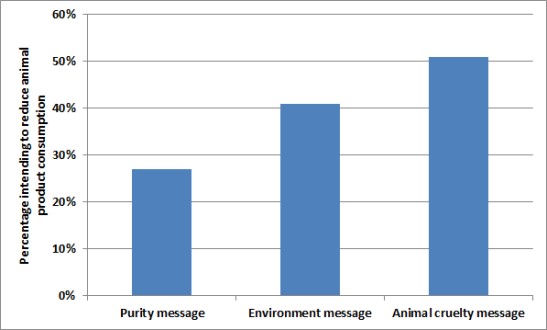
Source: Humane League Labs (2015)
Similarly, Faunalytics (2012) tested four different videos focusing on either animal cruelty, animal individualisation, environmental arguments, or health arguments. They found that the animal cruelty produced the highest percentage of people considering eliminating animal products, followed by the animal individualisation video, the environment video, and finally the health video. Interestingly, this was almost the opposite of the videos in terms of engagement - most people abandoned the animal cruelty video before watching the whole video. This points to an inconvenient fact in animal advocacy: shocking images of animal cruelty are the most effective at inspiring change, but many people actively avoid such images (Humane League Labs, 2014d). For more on this, see Section 5 on media.
Tiplady, Walsh & Phillips (2012) found that pity, sadness and anger were typical responses to animal cruelty footage. Nonetheless, advocates should not shy away from using shocking images of animal cruelty (Jones, 1997). Whilst the industry routinely pushes back on animal advocates, often attempting to erode their credibility, Scudder and Mills (2009) found that a particularly graphic campaign by PETA against a corporate farm effectively eroded the credibility of the farm and increased the credibility of PETA. However, advocates should employ caution with the framings they use: in focus groups with non-activists, Mika (2006) found that comparisons of animal agriculture to rape and slavery would not play well with the public. Similarly, Bongiorno, Bain and Haslam (2013) found that PETA campaigns using sexualised images of women decreased viewers’ intentions to support the organisation.
There is some evidence that perceived cuteness plays a role in willingness to eat animals (Zickfield, Kunst & Hohle, 2018), though images of cute animals are not particularly effective at inspiring dietary change (Mercy For Animals, 2017a; Humane League Labs, 2018). There is one exception to this: Mercy For Animals (2017a) found that comparisons of farm animals to companion animals is an effective means of encouraging people to reduce their animal product consumption. This type of content is found to be particularly effective on social media (Mercy For Animals, 2015). This is likely because it breaks down the dissociation between meat and animals: Kunst and Haugestad (2018) found that the ability to dissociate meat from dead animals played a significant role in willingness to eat it. This was especially the case for consumers in highly developed countries where truly unprocessed meat is rarely seen. Likening animals to humans is also effective, though crucially, likening humans to animals is not (Bastian et al., 2012).
Animal cruelty messages seem to be the most effective at inspiring dietary change on aggregate, though this may not be the case for all consumers. Survey data bears this out: Humane League Labs (2014b) asked a large sample of vegans, vegetarians, meat-reducers, and some omnivores what their initial motivation was for reducing animal products in their diet. Amongst vegetarians and vegans, 44% said the environment was a primary concern, 50% said their health was, and 66% said animal welfare. However, the opposite was true for meat reducers: amongst meat reducers and omnivores, 55% said health was a primary reason, compared to just 30% who said animal welfare was. This may indicate that the optimal strategy consists of multiple different messages aimed at different audiences. Health messages may be most useful for encouraging a certain set of people to reduce their consumption of animal products - but again, we should be wary of pressing the message ‘reduce red meat consumption’, since this will likely be displaced by chicken or fish, causing more animal suffering overall.
It is worth noting that many of these studies focused on a younger audience, either by design or incidentally. Pribis, Pencak, and Grajales (2010) found that younger people were significantly more concerned with animals and the environment, whereas older people were significantly more concerned with health. This may account for some of the higher receptivity to animal welfare arguments in these studies. It is also thought that consumers’ motivations for reducing animal product consumption differ in terms of their subsequent rate of relapsing to an omnivorous diet. Though research on this topic is lacking, Faunalytics (2014) found that an astonishing 84% of vegetarians and vegans eventually go back to eating animal products. Common factors amongst ex-vegetarians and vegans include a lack of social connections to other vegetarians/vegans, transitioning to the diet too quickly, and food cravings. Given that there are five times as many ex-vegetarians and vegans as there are current vegetarians and vegans, further study on retention may be warranted.
A fourth study by Humane League Labs (2014c) illustrates the importance of considering which products consumers reduce. They tested the efficacy of pro-vegetarian pamphlet pages focusing on (A) animal cruelty only, (B) health benefits only, (C) animal cruelty, health benefits, and environmental benefits, or (D) health and animal cruelty messages. They found that pamphlet A (animal cruelty only) led to the greatest proportion of people intending to reduce their animal product consumption: 52.3% who saw this page intended to change their diets, compared to 33.7% who saw B, 46% who saw C, and 41% who saw D. However, when asked about which animal products they would reduce, those who saw page A said they would be most inclined to reduce their red meat consumption, and therefore spared the least days of animal suffering - they spared, on average, just 92 days of suffering, compared to 139 days for those who saw page B, 154 days for those who saw page C, and 178 days for those who saw page D. This illustrates the importance of focusing on poultry, fish, and egg consumption, and presents advocates a challenge: how to motivate consumers to reduce these products in particular.
Humane League Labs (2014a) found that leaflets that only featured pictures of chickens were significantly less persuasive than leaflets which also featured pictures of other farm animals. This is probably because people perceive chickens and fish as less sentient. Mercy For Animals (2017b) asked people to rate animals’ intelligence, and ability to feel pain and pleasure on 0-10 scales. The results are shown here:
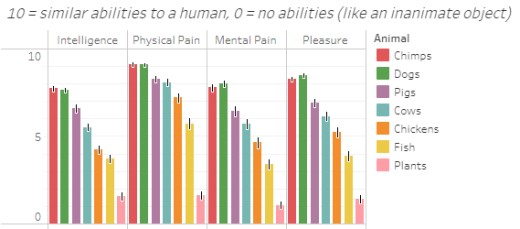
Source: Mercy For Animals (2017b)
Higher belief in sentience for each creature was also correlated with lower consumption of their meat. It appears that most people intuitively think that pigs and cows have richer experiences of life than chickens and fish. Interestingly, we also see a bias towards dogs, with people rating them as more able than chimps to feel mental pain and pleasure. Plants, meanwhile, are rated consistently lower than one might think when debating omnivores on the topic of plant sentience.
The concern is that a focus on chickens or fish is ineffective at inspiring dietary change, but a focus on other animals such as cows and pigs could lead to more animal suffering if there is a substitution effect. However, Vegan Outreach (2016) found that people who newly avoided eating mammals were also likely to avoid eating chickens. Rather than a replacement effect, there was more likely to be an effect of reducing all meat consumption, and consumption of other animal products. Therefore, messages which focus on different farm animals are likely to lead to a reduction in chicken consumption, also.
Humane League Labs (2018) investigated which photos of farmed animals are the most effective at inspiring dietary change. The study varied the content of the photos (sick or injured animals, confined animals, dead or dying animals, or happy animals), the species (pigs, poultry, cows, or goats/sheep), the grouping (individuals, small groups, or large groups) and age (adults, babies, or adults and babies together). The study found that the photo content had the largest effect on intentions to reduce consumption of animal products. Photos of sick or injured animals were the most impactful, followed by photos of animals confined in small cages. Dead or dying animals were next most impactful, and happy animals were least impactful. In terms of species, photos of pigs are the most impactful, followed by poultry, cows, goats/sheep, and finally fish. The effect of groupings and age were the lowest, but it appears that large groups were the most impactful photos, and photos of mother and baby animals together.
Some of these findings are likely intuitive for advocates: photos of pigs are more impactful than photos of fish, for example. Most people say fish is more difficult to give up than meat (Humane League Labs, 2014b), yet this poses a problem for advocates who are concerned about animal suffering since fish are killed in greater numbers and their production entails greater suffering. Mercy For Animals (2017c, 2017d) investigated which issues the public cared most about with respect to farmed fish welfare. They found that water quality was the most important issue for consumers; compared to other issues, this issue made people most likely to sign a petition to improve fish conditions, most likely to reduce their fish consumption, and most likely to avoid restaurants which condoned each practice. This may be because people thought poor water quality could affect them personally if they consumed the fish, compared to other less compelling arguments like overcrowding and handling.
3.2 Health Messages
Whilst studies have shown that animal cruelty messages are the most effective at inspiring dietary change overall, there are some consumers for whom environmental or health messages will be more effective (Humane League Labs, 2014b). Therefore, the optimal messaging strategy will address these issues as well; in particular, health messages may be more effective for older people (Pribis, Pencak, and Grajales, 2010).
As well as asking about primary motivations, Humane League Labs (2014b) reported the main concerns of those who said health was a factor. The most important concerns were reducing the risk of disease (42%), followed by avoiding contamination by antibiotics, hormones, and disease (36%), energy or wellbeing (25%) and finally losing weight (15%). Therefore, most health messages should be primarily framed around avoiding disease and contamination.
This is likely because these aspects of meat trigger a disgust reaction. A recent study found that disgust-oriented messages were more effective than health-oriented messages, and at least as effective as animal welfare messages (Palomo-Velez, Tybur & van Vugt, 2018). Therefore, portraying animal products as disgusting (i.e. contaminated with diseases, hormones, and antibiotics) is likely to be an effective strategy for health-conscious consumers.
Interestingly, there is some evidence that the way these benefits are stated affects how effective the message is. Bertolotti, Chirchiglia and Catellani (2016) find that factual statements (e.g. ‘a diet with a high content of meat is bad for your health’) are more effective than prefactual statements (e.g. ‘if you follow a diet with a high content of meat, your health will worsen’). This was true for health content, however the reverse was true for wellbeing content. Statements such as ‘if you follow a diet with a high content of meat, your psychophysical wellbeing decreases’ were more effective than statements like ‘a diet with a high content of meat is bad for your psychophysical wellbeing’.
Again, there is potential to cause more animal suffering if this message is not executed with care. On the whole, consumers on the whole perceive chicken and fish as healthier than pork and beef (Grimshaw, 2013), especially since red meat is now widely associated with some forms of cancer and other health problems (Micha, Michas & Mozaffarian, 2013; NHS, 2018). Therefore, health-conscious consumers may be inclined to replace their red meat consumption with white meat consumption, causing more animals to be killed.
However, there is evidence that white meat (particularly chicken) is more likely to carry bacteria such as Salmonella and E. coli compared to red meat (Public Health England, 2018). Indeed, the most common food poisoning bacteria are most prevalent in chicken, particularly Salmonella and Campylobacter (Yeung & Morris, 2011). Some studies have found the majority of chickens carry Salmonella due to contaminated feed and intensive rearing methods (Trickett, 1997), whilst others have found that up to one in ten chickens in major supermarkets has been infected by Salmonella (Meikle, 1999).
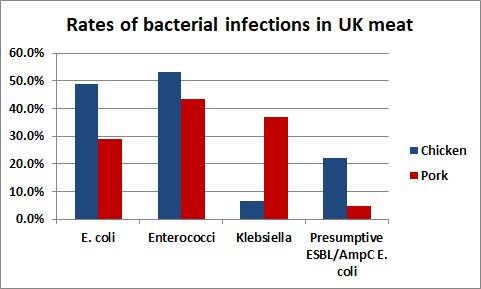
Source: Public Health England (2018)
This represents an opportunity for animal activists. Given that reducing the risk of diseases (42%) and avoiding contamination (36%) are the two most motivating health-related concerns for meat reducers (Humane League Labs, 2014b), activists should press on the key message that chicken, in particular, has a high risk of contamination. This could counter the trend of consumers predominantly having health concerns about red meat, and encourage health-conscious consumers to also cut their consumption of white meat.
3.3 Environment Messages
Although studies have shown environment-based messages to be less effective than animal cruelty-based messages, the environmental benefits of abstaining from animal products appear to be more readily accepted by the media. These messages are likely to be more appealing to a younger audience (Pribis, Pencak, & Grajales, 2010). Overall, the environment (44%) was less commonly cited as a motivation for reducing meat consumption compared to animal welfare (66%) and health (50%) (Humane League Labs, 2014b).
In a review of 38 studies, Hartmann and Siegrist (2017) found that the majority of consumers are not aware that meat production and consumption has a negative impact on the environment. They found that many consumers thought other aspects of food such as packaging and travelling a long distance had a more negative impact. However, there was some evidence from one study that awareness of the environmental impact of meat may be growing over time (Siegrist, Visschers & Hartmann, 2015).
Nonetheless, there is some evidence that messages about climate change lower meat consumption intentions (Abrahamse & Graham, 2017). In particular, a focus on the morality of engaging in pro-environmental behaviours is more effective than highlighting personal benefits; Postmes et al. (2012) found that messages about greenhouse gas emissions were more effective than messages about saving money in motivating drivers to keep their tyres inflated.
Again, this is a delicate issue with regards to animal suffering: whilst beef and dairy cause high levels of greenhouse gas emissions, chicken and eggs are relatively innocent with regards to emissions (Environmental Working Group, 2011). However, the latter products are associated with more animal suffering. Therefore, reducing red meat and dairy consumption is sensible from an environmental perspective - but if these are replaced by fish, chicken, and eggs, overall animal suffering will increase.
3.4 Focus On How To Change
Animal advocacy messages typically focus on the areas described above: animal cruelty, health, and the environment. Interestingly, most UK meat-eaters are already convinced that cutting out animal products brings about these benefits (Bryant, 2018). In a survey of 1,000 meat-eating adults in the UK, 72.7% believed that vegan diets are ethical, 69.3% believed they are good for the environment, and 50.3% believed they are healthy. Beliefs about vegetarian diets were even more positive.
The problem, it seems, is that people are unwilling to change their behaviour despite the benefits. The same survey found that just 24.5% thought a vegan diet was tasty, and just 22.5% thought it was affordable, whilst only 9.2% thought it was easy. Other evidence supports the view that taste and convenience are major barriers to moving towards veganism. A 2017 survey of UK meat-eaters found that enjoyment of meat was by far the most commonly cited reason for not being vegetarian (The Independent, 2017). Humane League Labs (2014b) also found that taste was the most common barrier for those who don’t want to go vegetarian (42%), whereas for those who want to go vegetarian but haven’t, the most common barriers were convenience and family (20% and 19% respectively).
This is an interesting situation for advocates - most meat-eaters agree that veganism is healthier, more ethical, and better for the environment, but are unwilling to reduce their meat consumption because they think it will be inconvenient and a sacrifice on taste. Whilst there is something to be said for continuing to highlight these key messages of why people should go vegan, there is also some evidence to support a message focusing on how to go vegan.
Humane League Labs (2014b) found that 34% of the omnivores they surveyed were willing to reduce their animal product consumption, but only 54% of those who were willing knew how to start. Focusing on how to make changes has proved effective in experimental studies, too: Humane League Labs (2014a) found that people who received a pro-vegetarian booklet focused on how to go vegetarian reported diet changes that spared 50% more animals than those who received a booklet focused on why to go vegetarian. Allen and Witte (2000) find some supporting evidence in fear-based appeals: when people perceive they have an ability to mitigate a threat, they are most likely to change their behaviour, whereas when they perceive a lack of ability to mitigate the threat, they most likely have a defensive response.
By far the most common source of information people use for advice on how to reduce or eliminate animal product consumption is websites (Humane League Labs, 2014b). 73% of respondents said websites were a good source for this information, compared to 58% who said books, and 43% who said friends and family. Websites are a great resource, therefore, for people who want to find out more on how to go vegan, but are down the list of resources for what influenced people to reduce their consumption of animal products initially. For this question, the most common resources are documentaries and movies (45%), other (40%), books (36%), thinking of it oneself (36%), and conversation (35%). Websites were influential for just 19% (Humane League Labs, 2014b).
3.5 Message Framing
There are other decisions to be made regarding message content, in particular how the messages are framed.
Accompanying persuasive messages, advocacy materials will typically contain a call to action, for example, ‘Go Vegan’. In recent times, animal advocates with a focus on effectiveness have tested whether some calls to action are more effective than others. Unfortunately, these studies have thus far failed to find significant differences between calls to action. The Animal Welfare Action Lab (2016) found no significant difference between a ‘reduce meat’ message and an ‘eliminate meat’ message, whilst Humane League Labs (2017a) also found no significant differences between ‘eat vegan’, ‘eat vegetarian’, ‘eat less meat’, and ‘cut out or cut back on meat’ messages, though they note that the study was underpowered to conclude that these messages are equally effective. Similarly, Mercy For Animals (2017e) found no significant differences between the messages ‘Please choose vegan’, ‘Please leave animals off of your plate’, and ‘Please cut out or cut back on animal products’ - though ‘Please choose vegan’ performed worse than the other two messages.
A more fruitful area of research has been on presenting vegan dishes. Humane League Labs (2014d) found that vegan food was the most appealing cover image for vegetarian literature, and was selected more than images of people or cute animals. In a separate study, they also found that omnivores found familiar dishes, such as roast potatoes, pasta with tomato sauce, and garden salads most appealing, whilst tofu, bean soups, and certain vegan meat alternatives were least appealing (Humane League Labs, 2015b). Duchene and Jackson (2017) found that people who read about plant-based foods with an emphasis on promoting autonomy and new choices reported a stronger intention to reduce their meat consumption compared to those who read a controlling motivational framing.
There has also been some research on producing effective social media advocacy content. Content which arouses strong emotions is the most likely to go viral (Berger & Milkman, 2012; Nelson-Field, Riebe & Newstead, 2013) and will therefore reach more people. Mercy For Animals (2015) conducted an in-depth analysis of the features of Facebook posts which result in the highest number of people seeing them, and identified these ‘nine rules for dominating Facebook’:
- Post many videos.
- Make people feel strongly (especially sad, angry, amused or nauseous).
- Use fewer than 10 words.
- Ask for shares rather than likes or comments.
- Use quotes.
- Link to a news article, rather than a blog, for more traffic.
- If it’s about an animal, make it a baby.
- Show farmed animals with companion animals.
- Post memes and photos of food.
In a separate study, Mercy For Animals (2016a) found three important factors which made short videos more persuasive: having a narrator (rather than just subtitles), having a celebrity narrator, and discussing farmed animal intelligence. Videos with narrators, especially celebrity narrators, were more persuasive than videos with subtitles only, and a comparison of farmed animal intelligence to that of cats and dogs also made videos much more persuasive.
Target groups
Overall, the best strategy is likely to try and reach as many people as possible. Faunalytics (2018a) find that a surprisingly high proportion of the public claim to care about farm animal welfare. In the U.S., around 73% agree that animals can feel, and around 78% agree that farm animal welfare is important - 54% even agree that farm animals deserve the same consideration as pets! Despite the majority of consumers failing to connect their meat-eating with animal suffering (Faunalytics, 2018b), there is a large group of consumers who are potentially persuadable. Sentience Institute (2017) found that 49% of US adults would support a ban on factory farming, 47% would support a ban on slaughterhouses, and 33% would support a ban on animal farming.
However, despite surprisingly high support for these policies, very few people actually change their diets to reflect these beliefs. There is reasonably good evidence that certain demographic groups are more likely to reduce their animal product consumption than others. Online and social media marketing gives the opportunity to target messages more than ever before, and therefore aiming persuasive messages at the most receptive audiences is a good strategy to maximise the efficiency of campaigns to change consumer behaviour.
The following are traits which are shown to be associated with higher rates of vegetarianism and veganism (Dello-Iacovo, Clifton & Reese, 2016):
● Female (Cooney, 2014; Humane League Labs, 2014b)
● Young (Cooney, 2014; Humane League Labs, 2014b)
● Liberal or left-leaning (Cooney, 2014; Humane League Labs, 2014b)
● City-dwelling (Cooney, 2014)
● Intelligent or well-educated (Cooney, 2014; Humane League Labs, 2014b)
● Higher income (Cooney, 2014; Humane League Labs, 2014b)
● Not following a Judeo-Christian religion (Cooney, 2014; Humane League Labs, 2014b)
● LGBT (Cooney, 2014)
● Single (Cooney, 2014)
● Artistic (Cooney, 2014)
● Introverted (Cooney, 2014)
Many of these characteristics, such as female, young, and city-dwelling, can be targeted directly through Facebook adverts. Others, such as liberal or left-leaning and artistic, may be able to be deduced based on other Facebook interests. Therefore, persuasive adverts encouraging people to move towards veganism can be effectively targeted at the most receptive demographics. However, there may be benefits to targeting other demographics, too. For example, although women are more likely to give meat up, men consume about 50% more meat than women (Prättälä et al., 2006). Therefore, targeting men has a higher potential number of animals saved.
Dagevos & Voordouw (2013) find some evidence that different consumer segments reduce their meat consumption for different reasons, and at different rates. ‘Conscious flexitarians’ actively reduce their meat consumption due to health and ethical concerns. They are typically well-educated females. ‘Unconscious flexitarians’ have a positive view of vegetarian meals, though they do not have strong beliefs about the ethical or health reasons for reducing meat consumption. ‘Extravert flexitarians’ are typically younger, and reduce their meat consumption primarily for prestige rather than principle. ‘Disengaged meat-eaters’ are those who have no particular moral views about meat, but are not particularly attached to it. Understanding this variety of consumer groups, and targeting communications accordingly, could help appeal to the specific concerns of different consumers.
There may also be an argument for targeting communications at current or former vegetarians and vegans. Some data shows that 84% of vegetarians and vegans eventually relapse to eating animal products (Faunalytics, 2014), and a potential reason is a lack of connection with other vegetarians and vegans. Keeping these people motivated, persuading vegetarians to become vegan, or encouraging them to become activists and/or donors are all reasons for targeting current vegetarians and vegans. Meanwhile, 30% of former vegetarians and vegans will try to go back to vegetarianism/veganism, whilst 37% say they want to (Faunalytics, 2014). However, Animal Charity Evaluators concluded using data from the same study that reducing recidivism is unlikely to be as cost-effective as traditional forms of vegan outreach such as leafleting (Dello-Iacovo, Clifton & Reese, 2016).
Media
There are a variety of forms of media which advocates can use to reach consumers. A key problem is that, although images of animal cruelty are amongst the most powerful in changing behaviour, most consumers actively avoid such images (Humane League Labs, 2014c, 2014d, 2015a). This is an argument for using very public adverts such as billboards which are difficult to avoid. It is difficult to measure the effectiveness of this kind of strategy, and as such there is currently no evidence on how effective billboards are at reducing animal product consumption. However, this tactic does get round the key hurdle of people avoiding animal cruelty content.
Some animal rights campaigners may be concerned about bringing attention to particularly cruel farming practices in the media, since this could give the message that animal exploitation would be permissible under better conditions. However, there is good evidence that media coverage of corporate or legislative welfare reforms decreases consumption of animal products. Lusk (2010) found that coverage of Proposition 2 in California, which banned cages for egg-laying hens, decreased demand for caged eggs and increased demand for cage-free eggs. Whilst the overall demand did not change in this case, Tonsor and Olynk (2010) found that media coverage about chicken and pig welfare decreased demand for pork and poultry over 10 years. More recently, Mercy For Animals (2016c) tested this experimentally, again finding that reading about corporate policy reform or legislative reform which improved animal welfare decreased intentions to buy the relevant animal products. Moreover, Faunalytics (2018a) found that 73% of the public support using media to reach the public with animal protection messages. Therefore, advocacy organisations committed to animal rights rather than welfare should still celebrate and encourage such welfare reforms, and boost their media coverage where possible.
Overall, the evidence suggests that leafleting can lead to dietary change for a small number of people. Humane League Labs (2017b) observed about 2% of those who received a vegan advocacy leaflet reporting that they became vegetarian or pescatarian as a result. Animal Charity Evaluators (2013) found that people who received a vegan leaflet reported a significantly higher reduction in animal product consumption compared to those who received a control leaflet. However, Humane League Labs (2017b) found no significant difference between those who received an advocacy leaflet and those who did not. Overall, these findings suggest that the effect of leafleting is quite small, though it likely does have a positive impact.
The evidence regarding online adverts is similarly weak, overall. Faunalytics (2012) found some effect of watching adverts about the environment, health, or ethics, finding that animal ethics messages were the most compelling. Similarly, Humane League Labs (2013) found a difference in the rate of young women ordering vegetarian literature after watching two different videos (1.5% vs. 2.7%). However, Mercy For Animals (2016b) found no significant difference in dietary intentions between those who watched an animal cruelty video and those who watched a control video. Therefore, overall, the evidence for the effectiveness of online adverts is similarly weak, though it is likely that they do cause some people to change their diets.
Indeed, Humane League Labs (2014b) report that, in a sample of mostly vegetarians and vegans, 53% reduced or eliminated their meat consumption after seeing printed farm animal cruelty materials such as leaflets, whereas 59% reduced or eliminated their meat consumption after seeing farm animal cruelty videos. They also found that, when asked to choose three resources which were most influential in leading them to start reducing animal product consumption, 16% said online videos were influential, 11% said social media was influential, and just 7% said leaflets were influential. The most commonly cited sources of influence in this survey were conversation (35%), thinking of it themselves (36%), books (36%), other (40%) and documentaries/movies (45%).
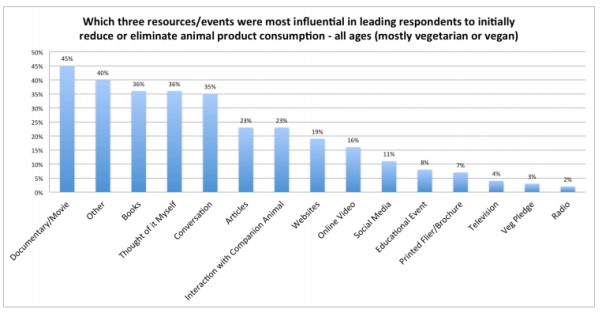
Source: Humane League Labs (2014b)
Given the dominance of documentaries and movies as a source of influence for creating vegans, advocates should seriously consider paying people to watch these films. This has been done before in the U.K. (Metro, 2016), and although there is no formal evidence for its effectiveness, advocates who have carried out this intervention report many viewers refusing the money afterwards, and asking lots of questions about veganism.
Humane League Labs (2014b) also found that, although websites were not a prominent source for persuading people to go vegan, they were the most common source for informing people how (73%) and keeping them motivated (39%). This suggests that animal advocacy websites, which are likely mainly visited by people who are already persuaded that action is necessary, should focus on practical advice on how to go vegan and information about how vegans are making a difference rather than arguments why people should go vegan.
Although social media was not reported as a main source of influencing consumers to reduce their consumption of animal products, it does offer a uniquely precise platform for targeting the most receptive audiences. In an analysis of 1,600 animal advocacy Facebook posts, Mercy For Animals (2015) gave ‘Nine rules for dominating Facebook for farmed animals’ (see Section 3.5 on message framing). More recently, they published a cross-platform analysis of all social media content, and reiterated the conclusion that ‘Facebook dominates social media and videos dominate Facebook’ (Mercy For Animals, 2018). Other key lessons from these analyses are to post emotive content and ask for shares rather than likes or comments (Mercy For Animals, 2015).
Finally, Carfora, Caso and Conner (2017) have demonstrated that SMS reminders are an effective intervention for those who want to reduce their meat consumption. A daily text message focusing on anticipated regret resulted in a significantly higher reduction in processed meat consumption compared to a control group. A similar intervention could be useful for new vegans to keep them motivated.
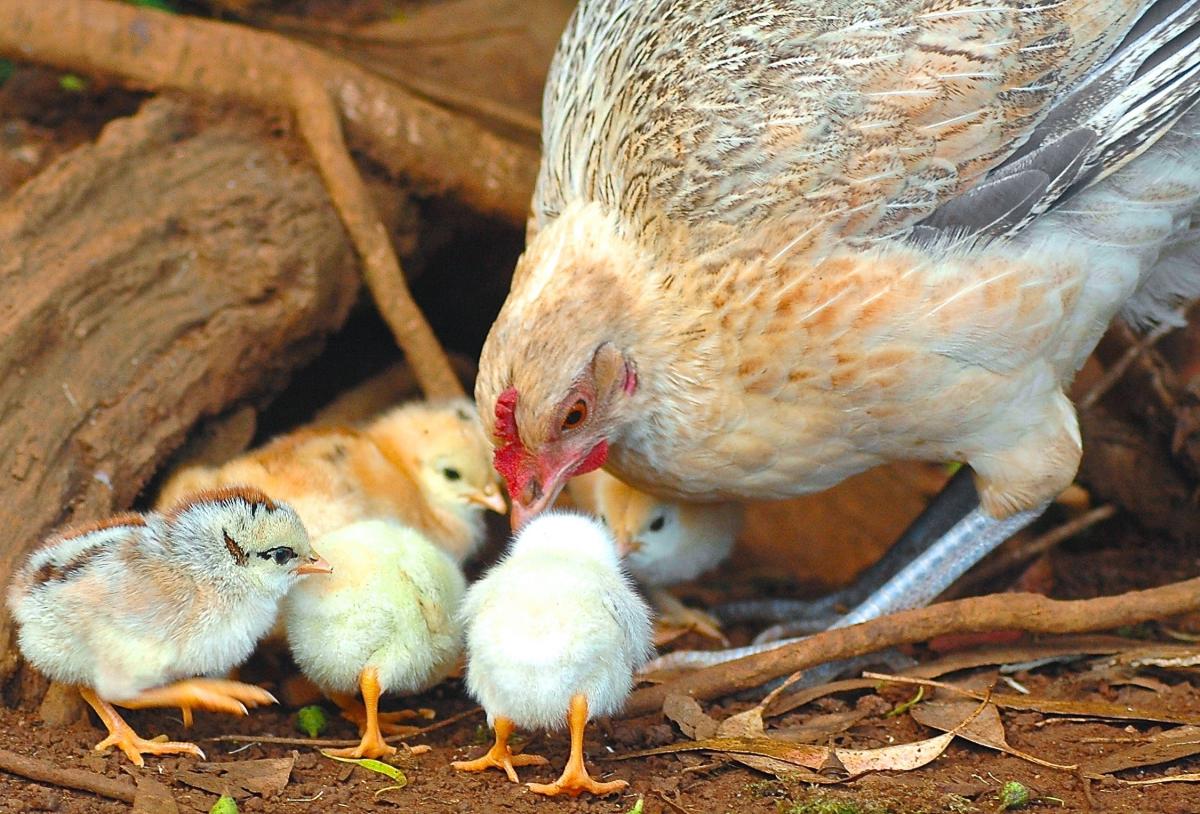
6. Conclusion
In conclusion, consumer-facing campaigns can help to alleviate the most animal suffering by adhering to these general rules:
Strategy: Campaigns should focus on farmed animals, rather than animals in shelters or labs, simply because of the sheer numbers of animals involved. Furthermore, advocates should be aware that fish and chickens make up over 99% of farmed animals in the U.K. and suffer more than other farmed animals, and should be prioritised accordingly.
Message content: Animal cruelty messages are the most effective at changing consumer behaviour on aggregate, though some consumers may find health or environmental arguments more compelling. Though fish account for the majority of farmed animal suffering, they are the least persuasive species to use in advocacy materials. Advocates should be wary that health- or environmentally-motivated consumers may reduce red meat consumption and replace it with white meat, which would lead to more animal suffering.
Target groups: It is possible to persuade a wide range of consumers, and the best strategy overall is to reach as many people as possible. However, there are some demographics who are particularly receptive to the vegan message, namely young women, left-leaning, city-dwellers, well-educated, and high income.
Media: There is mixed evidence on the effectiveness of leafleting and online advertising. However, social media posts can be optimised to reach more people and be more effective at changing behaviour. Whilst websites are a good medium for giving information on how to go vegan, documentaries appear to be the most common source of influence for vegans. Advocates could consider paying people to watch these documentaries, and/or displaying billboards in difficult-to-avoid places - though there is no evidence on the effectiveness of these strategies, they may address major limitations of traditional forms of advocacy. Text message reminders for motivated meat-reducers are likely also to be an effective means of reducing meat consumption.
References
Animal Clock. (2018). 2018 Animal Kill Clock U.K. Available at https://animalclock.org/uk/
Animal Charity Evaluators. (2013). 2013 Leafleting Study. Available at https://animalcharityevaluators.org/advocacy-interventions/interventions/leafleting/2014-march/2013-leafleting-study
Animal Charity Evaluators. (2016). Why Farmed Animals? Available at https://animalcharityevaluators.org/blog/why-farmed-animals/
Animal Welfare Action Lab. (2016). The effects of “reduce” and “eliminate” appeals on individual meat consumption. Available at https://osf.io/nxrx3/
Bastian, B., Costello, K., Loughnan, S., & Hodson, G. (2012). When closing the human–animal divide expands moral concern: The importance of framing. Social Psychological and Personality Science, 3(4), 421-429.
Berger, J., & Milkman, K. L. (2012). What makes online content viral?. Journal of marketing research, 49(2), 192-205.
Bertolotti, M., Chirchiglia, G., & Catellani, P. (2016). Promoting change in meat consumption among the elderly: Factual and prefactual framing of health and well-being. Appetite, 106, 37-47.
Bongiorno, R., Bain, P. G., & Haslam, N. (2013). When sex doesn't sell: Using sexualized images of women reduces support for ethical campaigns. PloS one, 8(12), e83311.
Bryant, C. (2018). Reducing Animal Product Consumption: Studies of U.K. Meat-Eaters. Bristol: Viva!
Carfora, V., Caso, D., & Conner, M. (2017). Randomised controlled trial of a text messaging intervention for reducing processed meat consumption: The mediating roles of anticipated regret and intention. Appetite, 117, 152-160.
Cooney, N. (2014). Veganomics: The Surprising Science on What Motivates Vegetarians, from the Breakfast Table to the Bedroom. Brooklyn: Lantern Books.
Dagevos, H., & Voordouw, J. (2013). Sustainability and meat consumption: is reduction realistic?. Sustainability: Science, Practice and Policy, 9(2), 60-69.
Dello-Iacovo, M., Clifton, J., & Reese, J. (2016). Effective Animal Advocacy: A Review. Available at http://www.michaeldello.com/effective-animal-advocacy-review/
Environmental Working Group. (2011). Meat Eater’s Guide to Climate Change and Health. Available at https://static.ewg.org/reports/2011/meateaters/pdf/methodology_ewg_meat_eaters_guide_to_health_and_climate_2011.pdf?_ga=2.99934430.1544496152.1542895259-2053442600.1542895258
Faunalytics. (2012). 2013 Comparing effectiveness of videos and ads. Available at https://animalcharityevaluators.org/advocacy-interventions/interventions/online-ads/comparing-effectiveness-of-videos-and-ads/
Faunalytics. (2014). Study Of Current And Former Vegetarians And Vegans. Available at https://faunalytics.org/study-of-current-and-former-vegetarians-and-vegans/
Faunalytics. (2018a). Animal Tracker. Available at https://faunalytics.org/animaltracker/
Faunalytics. (2018b). Attitudes Toward Farmed Animals in the BRIC Countries. Available at https://faunalytics.org/wp-content/uploads/2018/09/BRIC-Full-Report.pdf
Grimshaw, K. (2013). Consumer perceptions of beef, pork, lamb, chicken and fish. MSc Thesis: Texas A&M University. Available at https://oaktrust.library.tamu.edu/bitstream/handle/1969.1/151396/GRIMSHAW-THESIS-2013.pdf?sequence=1
Hartmann, C., & Siegrist, M. (2017). Consumer perception and behaviour regarding sustainable protein consumption: A systematic review. Trends in Food Science & Technology, 61, 11-25.
Humane League Labs. (2013). Report: Which factory farming video is more effective? Available at http://www.humaneleaguelabs.org/blog/2013-07-19-which-factory-farming-video-is-more-effective/
Humane League Labs. (2014a). Report: What elements make a vegetarian leaflet more effective? Available at http://www.humaneleaguelabs.org/blog/2014-05-20-what-elements-make-vegetarian-leaflet-more-effective/
Humane League Labs. (2014b). Diet Change and Demographic Characteristics of Vegans, Vegetarians, Semi-Vegetarians, and Omnivores. Available at http://www.humaneleaguelabs.org/static/reports/2014/04/diet-change-and-demographic-characteristics1.pdf
Humane League Labs. (2014c). Report: Is One Message or Multiple Messages More Effective For Inspiring People To Reduce Meat Consumption? Available at http://www.humaneleaguelabs.org/static/reports/2014/09/one-versus-multiple-messages-study-results-updated.pdf
Humane League Labs. (2014d). Report: What Cover Photos Make People Most Interested In Reading Pro-Veg Literature? Available at http://www.humaneleaguelabs.org/static/reports/2014/08/cover-photos-study-humane-league-labs.pdf
Humane League Labs. (2015a). Report: Is Animal Cruelty, Environmental or Purity (“Abolitionist”) Messaging More Effective At Inspiring People To Change Their Diet? Available at http://www.humaneleaguelabs.org/static/reports/2015/09/animal-cruelty-vs-22abolitionist22-messaging.pdf
Humane League Labs (2015b). Report: Which Vegan Meals Do Omnivores Find Most Appetizing and Accessible? Available at http://www.humaneleaguelabs.org/static/reports/2015/01/appetizing-vegan-food-photos-study-results1.pdf
Humane League Labs. (2017a). Which Request Creates the Most Diet Change: A Reanalysis. Available at http://www.humaneleaguelabs.org/static/reports/E006R02-which-request-creates-the-most-diet-change.pdf
Humane League Labs. (2017b). Which Leaflet is More Effective: A Reanalysis. Available at http://humaneleaguelabs.org/static/reports/E001R02-which-leaflet-is-more-effective.pdf
Humane League Labs. (2018). Which Farm Animal Photos are Most Likely to Inspire People to Eat Vegan: A Reanalysis. Available at http://www.humaneleaguelabs.org/static/reports/E005R06-farm-animal-photos.pdf
Jones, D. M. (1997). Advertising animal protection. Anthrozoös, 10(4), 151-159.
Kunst, J. R., & Haugestad, C. A. P. (2018). The effects of dissociation on willingness to eat meat are moderated by exposure to unprocessed meat: A cross-cultural demonstration. Appetite, 120, 356-366.
Lusk, J. L. (2010). The effect of Proposition 2 on the demand for eggs in California. Journal of Agricultural & Food Industrial Organization, 8(1).
MacAskill, W. (2015). Doing Good Better: Effective Altruism and a Radical New Way to Make a Difference. London: Guardian Books.
Meikle, J. (1999). “Up to one in five chickens or turkeys contaminated”, The Guardian, 8 February.
Mercy For Animals. (2015). How to Dominate Facebook. Available at https://mercyforanimals.org/dominate-facebook
Mercy For Animals. (2016a). What Characteristics Make Videos Most Effective at Inspiring Individual Dietary Change? Available at https://mercyforanimals.org/making-effective-videos
Mercy For Animals. (2016b). Do Online Videos of Farmed Animal Cruelty Change People’s Diets and Attitudes? Available at https://mercyforanimals.org/impact-study
Mercy For Animals. (2016c). Welfare Reforms and Meat Consumption. Available at https://mercyforanimals.org/welfare-reforms-survey
Mercy For Animals. (2017a). Which Kinds of Pro-Vegetarian Videos are Best at Inspiring Changes in Diets and Attitudes? Available at https://mercyforanimals.org/kinds-of-viral-videos-are-best-at-inspiring
Mercy For Animals. (2017b). Perceptions of Farmed Fish Intelligence and Ability to Feel Pain and Pleasure. Available at https://mercyforanimals.org/perceptions-of-farmed-animal-intelligence
Mercy For Animals. (2017c). Which Farmed Fish Welfare Issues Does the Public Care Most About? (Activist Messaging) Available at https://mercyforanimals.org/which-farmed-fish-welfare-issues-does-the
Mercy For Animals. (2017d). Which Farmed Fish Welfare Issues Does the Public Care Most About? (Neutral Messaging) Available at https://mercyforanimals.org/which-fish-welfare-issue-generates-the-most
Mercy For Animals. (2017e). Which Call to Action Should We Use in Pro-Vegetarian Videos? Available at https://mercyforanimals.org/which-call-to-action-should-we-use-in-pro
Mercy For Animals. (2018). How to Dominate Social Media. Available at https://mercyforanimals.org/dominate-social-media
Metro. (2016). Activists are paying people £5 to watch a film about animal agriculture. Available at https://metro.co.uk/2016/02/03/%EF%BB%BFactivists-are-paying-people-5-to-watch-a-film-about-animal-agriculture-5659941/
Micha, R., Michas, G., & Mozaffarian, D. (2012). Unprocessed red and processed meats and risk of coronary artery disease and type 2 diabetes–an updated review of the evidence. Current atherosclerosis reports, 14(6), 515-524.
Mika, M. (2006). Framing the issue: Religion, secular ethics and the case of animal rights mobilization. Social Forces, 85(2), 915-941.
Nelson-Field, K., Riebe, E., & Newstead, K. (2013). The emotions that drive viral video. Australasian Marketing Journal (AMJ), 21(4), 205-211.
NHS. (2018, February 1). Red meat and the risk of bowel cancer. Available at https://www.nhs.uk/live-well/eat-well/red-meat-and-the-risk-of-bowel-cancer/
Norwood, F. & Lusk, J. (2011). Compassion, by the pound: the economics of farm animal welfare. Oxford: Oxford University Press.
Palomo-Vélez, G., Tybur, J. M., & van Vugt, M. (2018). Unsustainable, unhealthy, or disgusting? Comparing different persuasive messages against meat consumption. Journal of Environmental Psychology, 58, 63-71.
Prättälä, R., Paalanen, L., Grinberga, D., Helasoja, V., Kasmel, A., & Petkeviciene, J. (2006). Gender differences in the consumption of meat, fruit and vegetables are similar in Finland and the Baltic countries. European Journal of Public Health, 17(5), 520-525.
Pribis, P., Pencak, R. C., & Grajales, T. (2010). Beliefs and attitudes toward vegetarian lifestyle across generations. Nutrients, 2(5), 523-531.
Public Health England. (2018). Willis, C., Jorgensen, F. Elviss, N., Cawthraw, S., Randall, L., Ellington, M., Hopkins, K., Swift, C., & Woodford, N. Surveillance Study of Antimicrobial Resistance in Bacteria Isolated from Chicken and Pork Sampled on Retail Sale in the United Kingdom.
Scudder, J. N., & Mills, C. B. (2009). The credibility of shock advocacy: Animal rights attack messages. Public Relations Review, 35(2), 162-164.
Sentience Institute. (2017). Survey of US Attitudes Towards Animal Farming and Animal-Free Food October 2017. Available at https://www.sentienceinstitute.org/animal-farming-attitudes-survey-2017
Sentience Institute. (2018). 3 Big Changes We Need in the Farmed Animal Movement. Available at https://www.sentienceinstitute.org/blog/three-big-changes
Siegrist, M., Visschers, V. H., & Hartmann, C. (2015). Factors influencing changes in sustainability perception of various food behaviors: Results of a longitudinal study. Food quality and preference, 46, 33-39.
The Independent. (2017, August 7). Aggressive vegans are putting a quarter of Britons off vegetarianism, finds study. Available at https://www.independent.co.uk/life-style/food-and-drink/vegans-aggressive-british-people-turn-off-vegetarianism-meat-dairy-study-a7880251.html
Tomasik, B. (2018a) How Much Direct Suffering Is Caused by Various Animal Foods? Available at https://reducing-suffering.org/how-much-direct-suffering-is-caused-by-various-animal-foods/
Tomasik, B. (2018b) Is Brain Size Morally Relevant? Available at https://reducing-suffering.org/is-brain-size-morally-relevant/
Tonsor, G. T., & Olynk, N. J. (2011). Impacts of animal well‐being and welfare media on meat demand. Journal of Agricultural Economics, 62(1), 59-72.
Trickett, J. (1997). Food Hygiene for Food Handlers, 2nd ed. Basingstoke: Macmillan Press Ltd.
Yeung, R. M., & Morris, J. (2001). Food safety risk: Consumer perception and purchase behaviour. British Food Journal, 103(3), 170-187.
Zickfeld, J. H., Kunst, J. R., & Hohle, S. M. (2018). Too sweet to eat: Exploring the effects of cuteness on meat consumption. Appetite, 120, 181-195.
The views expressed by our Research News contributors are not necessarily the views of The Vegan Society.
The views expressed by our Research News contributors are not necessarily the views of The Vegan Society.

